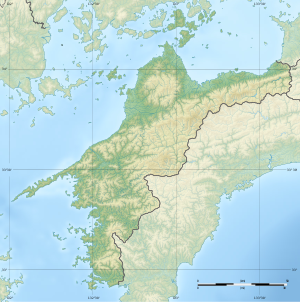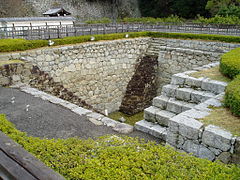Matsuyama Castle (Iyo)
| Matsuyama-jō | ||
|---|---|---|
|
The castle tower (rear) of Matsuyama |
||
| Alternative name (s): | Katsuyama Castle, Golden Turtle Castle | |
| Creation time : | 1602 | |
| Castle type : | Hirayamajiro (hill castle) | |
| Conservation status: | Castle tower, watchtowers, gates, walls and moat (partially) preserved | |
| Construction: | Stone, wood | |
| Place: | Matsuyama | |
| Geographical location | 33 ° 50 '43.9 " N , 132 ° 45' 56.6" E | |
| Height: | 130 m TP | |
|
|
||
The Matsuyama Castle ( Japanese (伊 予) 松山 城 , (Iyo-) Matsuyama-jō ), also Katsuyama Castle ( 勝 山城 , Katsuyama-jō ) or "Golden Turtle Castle" ( 金 亀 城 , Kinki-jō ), the former Iyo Province on Shikoku is the most spectacular sight of Matsuyama , the capital of Ehime Prefecture .
history
Katō Yoshiaki received a fiefdom (60,000 koku ) in 1595 in the area of today's Matsuyama and moved into Masaki Castle. After the Battle of Sekigahara , he was upgraded to 200,000 koku and built a large castle complex on the Katsuyama, including a residence at the foot of the mountain. For this purpose, the castle town with its right-angled street pattern was laid out according to plan . 1627 Katō was transferred to Aizu-Wakamatsu , with the local lord of the castle Gamō Tadatomo Matsuyama received as a fief in return. Since the Gamō line died out in 1634, the fiefdom was transferred to the Hisamatsu (a Matsudaira branch) in 1635 with a donation of 150,000 koku . The Hisamatsu remained lords of the castle for 16 generations until the Meiji Restoration . They also provided the princes of Kuwana .
The castle complex consists of an elongated Honmaru on the 130 m high summit of the hill, which ended in a square with the castle tower. The residence in Ni-no-Maru or San-no-Maru was located at the foot of an area surrounded by a wide moat. In front of it, also on this site, there were apartments of vassals and staff. Since the fiefdom was returned to the Tennō or to the state at the beginning of the Meiji period and thus became public property, the area of the San-no-Maru could be used for a park, in which there is also a stadium, a baseball stadium and the Prefecture's Picture Gallery. The grounds of the residence have been restored in recent years after being damaged by bombs in World War II. The main tower, six watchtowers, seven gates and seven pieces of wall are designated as an important cultural asset of Japan .
Individual evidence
literature
- 三浦 正 幸 : 図 説 江 戸 三百 藩 「城 と 陣 屋」 総 覧 - 決定 版 (西 国 編) . Gakken, 2006, ISBN 4-05-604379-5 .
- Association of Castle Administrations: Bookmarks of Castles , 2005. (Japanese)
- 八 幡 和 郎 : 江 戸 の 殿 さ ま 全 600 家 . Kodansha, 2004, ISBN 4-06-256869-1 .
- Miyaji, Saichiro (Ed.): Bakumatsu shoshu saigo-no hanshu-tachi. Nishinihon-hen. Jinbunsha, 1997. ISBN 978-4-7959-1906-8 .







